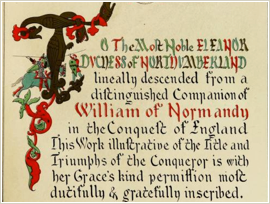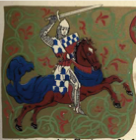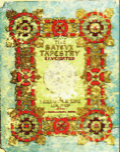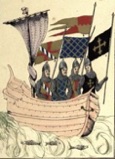Are we Normans?
In a couple of these blogs I have alluded to our putative origins. The earliest possible date for our ancestors in Scotland would have been after the end of the last ice age, i.e. around 10.000 BC (actual settlements or artifacts of human civilization in Scotland date from 8500 BC) and I noted that it looks as though they may have come up from Southern Europe, though doubtless others came from the Russian steppes via Scandinavia. Over the millennia there would have been a mixing of blood even before the Picts and the Scots and then the odd Viking or two. But in so far as the Raitts are concerned, current research (by interested name-bearers) shows that they may have had their more recent origins in northern France and indeed come over to England in 1066 with William the Conqueror.
According to Augustin Thierry in his 1856 work History of the Conquest of England by the Normans and its Causes and Consequences in England, Scotland, Ireland and on the Continent, in the period 1137-1189 the hospitality which the chiefs of Scotland accorded to the men of Saxon race fleeing from the Normans, was offered by them also to men of Norman race who were discontented with the share which had fallen to them in the division of the conquest, or who had been banished from England by the sentence of their own leaders. These sons of the conquerors came in great numbers to seek fortune where the conquered had found refuge. Most of them were tried soldiers and the Scottish kings, delighted to have such Norman knights to fight against their English foes, took them into their service. They received them into their intimacy, confided high commands to them, and even, to render their court more agreeable to these new guests, studied to introduce into the Teutonic language spoken there, many French words and idioms.
In the historical background to the Book of Deer (a tenth century illuminated manuscript from North East Scotland) it is noted that the first record of Normans appearing in Scotland was in 1054 when mercenaries fought in a battle between rival Scots. However, it is during the reigns of William I (1165-1214) and Alexander II (1214-1249) that the Norman presence in northern Scotland becomes particularly noticeable. (Indeed, William himself seems to have had Norman heritage.) The King of Scots was able to focus on extending royal authority north of the Mounth in areas like Moray and Ross. As challenges to this authority were surmounted, “lands in Moray, Ross, Sutherland and Caithness were granted to families – usually of Norman or Flemish extraction – loyal to the kings of Scotland. In the North-East probably the best example of this process was the granting of the Lordship of the Garioch before 1182 to the brother of William I, David, Earl of Huntingdon. In turn, David granted lands within his new Lordship to Norman and Flemish families like de Boiville, de Audri, le Bret and Bertolf. More importantly perhaps, royal control of this Lordship, together with the building of a new motte and bailey fortification at Inverurie, meant that the kings of Scotland effectively controlled the main overland routes from Aberdeenshire to Moray. William Comyn was the first Norman earl of any Scottish province and by 1286 another four Scottish earldoms were controlled by families of Anglo-Norman origin.”
However, a BBC web page on the impact of the Normans places their position there somewhat earlier. “Although the Normans did not invade Scotland, Norman influence was introduced to Scotland under David I (1124–1153) where it had as great an impact as south of the Border. David established Abbeys, promoted trade and introduced changes to the legal system, all of which were to have an impact on the future of Scotland. Equally importantly, he granted lands to Norman nobles who would form the new ruling class of Scotland, the descendents of whom were to play important roles in the struggle for independence. The Normans had formalised land ownership in England, creating a bureaucracy and introducing written title deeds to denote ownership. David brought this structure to Scotland, and granted land to nobles who had been part of the conquest and who understood the administration of such a system. In doing so he created a new ruling elite in Scotland. Oliphant, de Bourneville, de Graham, Fitzalan, Comyn, de Bailleul (Balliol), and de Brus (Bruce) are amongst the names of the early landlords and are mostly of French or Flemish origin.”
As also noted in an earlier blog, people usually had a Christian name which was coupled with either their trade or the place they came from to distinguish them from others; and this gradually evolved into the surname Thus many Normans will have brought their place of origin with them as part of their name (e.g. Henri de Beauvoir, Simon de Montfort – though whether these are really French locations or English is not always apparent.) Since the Normans gradually expropriated (or were granted) virtually all lands belonging to Anglo-Saxon owners, then such local English village names may well have been reflected in their names instead - though equally the new Norman owner’s name was sometimes used, eventually becoming anglicized. Like many others, as indicated above, the great Scottish family of Lindsay (in fact, my maternal grandmother’s family) is reputed to have distinct Norman roots (de Lindsey) – though an analysis of heraldic devices appears to establish they were of Flemish descent. And other notables in Scotland such as, for instance, Andrew de Moray, Reginald le Chen, and James de Mar and James de Maleville of the county of Aberdeen and William de Rotheneth of the county of Elgyn, likely also had Norman roots judging by their names.
We know that our Gervaise de Rathe (Rait) of the county of Invernarn was a witness to the deed transferring the property of Kilravock to the Rose family. Hugh Rose’s wife Marie was the daughter of Sir Andrew de Bosco who is described as a Norman knight. And it thus highly likely that Gervaise himself was also from such a Norman family who were given lands and high offices and favours in the region of Nairn and who built a castle thereon. Thus the castle of Rait took its name from Gervaise’s family rather than vice-versa – that is to say that if rathe (and variants) is Gaelic for a fortified place, then it is probably just sheer co-incidence that Gervaise had a similar “surname”. After all, if he assumed his name from the castle locale, then you would expect there to be many other people called de Rathe because they too built or lived in a castle or fortified place. But in fact there are not. Thus, although he is given in various texts as de Rathe – this may simply be a confusion between the place and the name – Gervaise de Rait (or Raite or even Rate) becoming Gervaise de Rathe instead.
What is interesting (possibly red-herring?) is that in northern France there was an ancient region of Retz (or Rais) – pronounced “ray” – named after the local land-owning family. The coat of arms and flag of this family was – a black cross on a yellow background! So perhaps an ancestor of Gilles de Rais came over to Britain with his Norman compatriots in 1066. (Equally, the name is in some documents spelled Rat or Raat – the latter is a name to be found in The Netherlands, and another similar name is Raets, to be found in Germany and elsewhere.)
And if, as conventional wisdom holds, the name Rathe/Rait died out in the north of Scotland because the family fled to the Mearns (Kincardineshire) in the early fifteenth century and if all the Raits and Raitts and Raites and Rathes and probably also Reats (but not the Raiths for some reason) are descended from these Raits in The Mearns (who subsequently moved further up into Aberdeenshire and further down into Angus – as well as all over the world due to the Highland Clearances, closure of mills, famine and disease etc), then it would seem that our Raitt ancestors, at least, were French rather than Pictish or Scots! Of course, some of the families that the Raitt’s married into could well have more ancient Scottish roots. More to delve into another day!
Sunday, 23 January 2011





